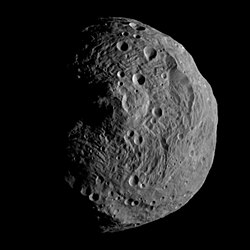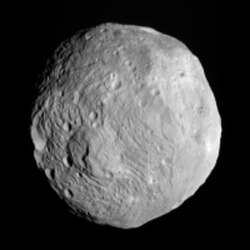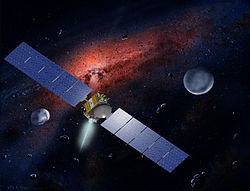PIA18788-VestaAsteroid-GeologicMap-DawnMission-20141117
November 17, 2014
http://www.jpl.nasa.gov/spaceimages/details.php?id=pia18788
http://www.jpl.nasa.gov/news/news.php?release=2014-399
This high-resolution geological map of Vesta is derived from Dawn spacecraft data. Brown colors represent the oldest, most heavily cratered surface. Purple colors in the north and light blue represent terrains modified by the Veneneia and Rheasilvia impacts, respectively. Light purples and dark blue colors below the equator represent the interior of the Rheasilvia and Veneneia basins. Greens and yellows represent relatively young landslides or other downhill movement and crater impact materials, respectively. This map unifies 15 individual quadrangle maps published this week in a special issue of Icarus. Map is a Mollweide projection, centered on 180 degrees longitude using the Dawn Claudia coordinate system.
JPL manages the Dawn mission for NASA's Science Mission Directorate in Washington. Dawn is a project of the directorate's Discovery Program, managed by NASA's Marshall Space Flight Center in Huntsville, Alabama. The University of California at Los Angeles (UCLA) is responsible for overall Dawn mission science. Orbital Sciences Corp. in Dulles, Virginia, designed and built the spacecraft. The German Aerospace Center, the Max Planck Institute for Solar System Research, the Italian Space Agency and the Italian National Astrophysical Institute are international partners on the mission team.
More information about Dawn is online at http://www.nasa.gov/dawn.Relevante Bilder
Relevante Artikel
(4) VestaVesta oder – in der Nomenklatur für Asteroiden – (4) Vesta (Aussprache [ˈvεsta]) ist mit zirka 516 Kilometer mittlerem Durchmesser nach Pallas der zweitgrößte, aber mit etwa 2,6·1020 Kilogramm der schwerste Asteroid im Asteroiden-Hauptgürtel, in dem er an Masse nur vom Zwergplaneten Ceres übertroffen wird. Vesta ist – wie Ceres und vermutlich auch Pallas – ein Protoplanet aus der Entstehungszeit des Sonnensystems. Sie hat einen relativ großen Metall-Anteil, ist etwas oval (möglicherweise durch eine Kollision in der Frühzeit) und ist der einzige Asteroid, der bisweilen freiäugig sichtbar wird. .. weiterlesen











